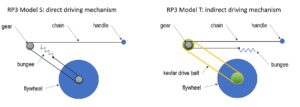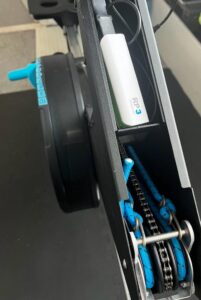(5) Can training on an RP3 improve my technique in the boat?
+
Training with RP3 is ideally suited for improving technique in the boat. It is not without reason that more and more national rowing teams use RP3 in their season build-up and during the season aid to train on and race preparation tool.
Certain technical improvements are better to tackle on the RP3 than in the boat because the monitor allows direct feedback. The physical accessibility of the rower on the machine also can help the coach. The particular point of interest then translates into a (for the rower) personal target power curve and even an optimal team power curve, which can be trained explicitly. Where necessary with the help of a spectator: coach or teammate close by for instructions.
With the RP3 “connection bars” it is possible to connect the indoor rowing machines (the flywheels) so that the pressure curve synchronisation can be trained. Side by side, two rowing together feels like a ‘coxless pair’. More two’s can be connected together so its possible to configue and four and even an eight.
Better individual technique, but also training equality, benefits the boat speed.
(2) How can I compare RP3 to the static ergometer I'm used to?
+
We get this question very often. The short answer is: it cannot be compared. Static and dynamic ergometers are just completely different. When reversing the movement of the rower’s body weight in static rowing, more energy is lost. And the body takes a hit with every stroke. Often and especially it causes (lower) lower back complaints and even injuries, and joints can also play up.
On RP3, the acceleration of the flywheel is measured for the score and the real time feedback and numbers in the monitor. Static machines usually measure the movement of the chain. Therefore, with a rowing style in which a firm final stroke is made with the arms, the score can be higher on a static machine.
However, this is not a natural and logical movement in the rowing boat. On the RP3 it has no (minimal) effect on the score. Better rowing does though!
Although the scores are not really comparable, it can be said from experience:
> more power rowing: higher scores on static ergometer
> more technique: better score on RP3
The technically better rowers score relatively better on RP3. The difference between RP3 and the common static ergometers on a 2,000m score is approx. 1-3s per 500m in favour of the more technical rower.
One of the big advantages, often mentioned by the users who do have much experience on both: on RP3 you can practise higher stroke rates more easy, so really can train at (boat) race pace and have very similar experience or feeling.
(3) How does training on an RP3 differ from rowing in a boat?
+
First of all, rowing on water is, of course, rowing on water. An RP3 stands on the mainland, on the ground, and that of course gives more stability. It is possible to use a ‘wobble seat’, which also simulates the lateral imbalance of a rowing boat. With a ‘wobble seat’ you can train to sit more upright and prevent imbalance.
In the boat, the catch; where the blades of the oar go into the water, is more difficult than on an ergometer. After the catch, the feeling of rowing is very comparable to the rowing stroke in the boat. Hang, build up pressure, finish with back and arms. The final part of the stroke is good to practise with RP3, where most – even experienced rowers – often lose pressure too quickly. The recovery is also comparable to a recovery in the boot.
Technique is a factor for better scores, whereas on a static ergometer just more force is also an option for better results. On RP3 Dynamic indoor rowing machines you are implicitly ‘forced’ to improve and be as technical as possible.
With RP3 you get direct feedback via the monitor (App on smartphone or tablet) about the shape of the power curve and the figures such as joules, watts and stroke length. There are many other fields (30) to select, besides the standard ‘stroke rate’, ‘split’ (time / 500m) and ‘average split. Rowing on RP3 therefore gives much more real time feedback over the rowing stroke. This makes RP3 a very suitable training machine for better rowing and improving your rowing technique.
With RP3 it is also possible to physically link 2 or more machines. This allows the synchrony of the pressure curve of the team of rowers to be trained. The software offers the possibility to analyse your own curve after the workout, but also the curves of the team (overlay) and expose the differences. This is input for improvement.
RP3 is also busy adding rowing data from boat training sessions to the log, so that this data can also be compared with rowing data from an ergometer training and vice versa.
(1) What is the difference between Dynamic and Static rowing on an ergometer?
+
On a Dynamic Indoor Rowing machine the flywheel is also moving as the seat does. So ‘everything’ is loose. The athlete even moves relatively much less than the flywheel, which corresponds to the situation and the feeling in the boat. That is the reason we are using “True Rowing Experience” as our motto.
> Static -> Body Mass turning, instead of just flywheel on Dynamic, very similar as in the boat
> Less stressful lower back, injury prevention and often even used for back injury recovery
> Dynamic rowing is much more like rowing on water and better useful as part of rowing event preparation or during the season
> Difference in scores: less hard in extensive (longer: 30min +) workouts, harder on fast (high pace) parts, but above all: dynamic is more like what you do in the boat during a race
(4) Can I also use an RP3 for fitness/crossfit purposes?
+
Indoor rowing is increasingly seen as the ideal workout, especially by non-rowers. Rowing uses a large number of muscles. Usually much more muscle groups than in other sports and at the same time it is not very stressful for the body. It is an ideal combination of muscle / strength training and ‘cardio’.
It is quite possible to perform all kinds of workouts on an indoor rowing machine (ergometer); from long / longer extensive (endurance) training, intensive endurance and HIIT (high intensity interval training). Muscle strength variations can also be included in these workouts. Indoor rowing is therefore increasingly used as a permanent part of a weekly training schedule, at different levels of experience and intensity with athletes.
Rowing, and therefore also indoor rowing, can be done up to a very old age. There are active rowers well over 80 years old, a number of whom are also still competitively active.
RP3 Rowing offers “RP3 Studio” that has been specially developed for gyms and fitness organisations. With this solution, multiple rowing machines in a room can be linked to a pre-set group session. The workout can be followed on a large screen, which can even use projection of real images of the most beautiful and famous rowing courses and rivers in the world.
The first gyms and fitness organisations offer a “RowStudio” offer: group lessons with the dynamic rowing machines. In addition, there are a number of rowing clubs and training centres with an RP3 Studio for group training in a team. Here the group lessons are more than a group of people doing the same group lesson together. Here the output of the teammates is measured in real time and compared with each other so that synchronisation of the rowers in the team can be actively worked on.
Difference: What is the - mechanical - difference between model S en model T?
+
The RP3 Model S is the original design with a direct drive of the flywheel. The newly invented and designed Model T has got an indirect drive with two pulley wheels and a kevlar belt. See below:

The Model S has got a slightly more direct feeling at the catch, whereas the Model T has got a fraction of a second delay, what actually is better comparable how you could pick up the boat at the catch to get better connection with the blade in the water.
But even the best rowers in the world have their own preference on this. Not good or better, just a little different.
Do you want to try for yourself and tell us your idea, please send us your request with the contact form.
What should I do when the app is not connecting with RP3?
+
First, make sure that you follow the guide for connecting your device to your RP3 over at the guide in the knowledge base.
Once you’ve followed that and you can still not make a connection, follow our list of solutions to frequent problems:
- Take a couple of strokes to make sure that the interface chip inside of the RP3 rower is active. This can often help to make a connection.
- If you are using a cable to connect the smart device to your RP3 rower, make sure that the cable is not broken or twisted. Cheap cables can often loose proper connection when twisted or used for a while.
- When using Bluetooth, make sure that the powerbank inside of the RP3 rower is charged. We have a video online on YouTube about charging and reconnecting your powerbank. Additionally, make sure that Bluetooth is enabled on your smart device.
- In some rare cases, the interface chip inside of the RP3 rower is broken, due to a faulty cable, moisture or other problems. A new interface chip can be ordered using the website.
Below is a picture helping you locate the powerbank inside the model S rower:

Lees meer over de NKIR met RP3
+